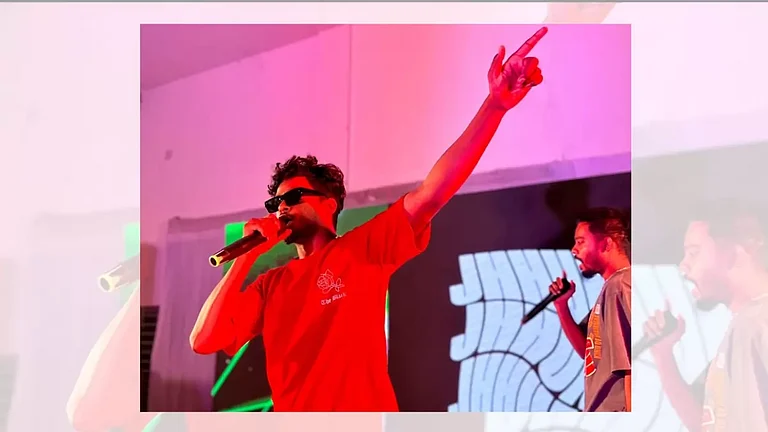24 ghante, 24 karat, 24 ki taiyyari hai; poora Bharat Modi mein hai, fir Modi ki baari hai.
How Hindutva Pop Music Is Aiding PM Modi's Rise
Hindutva pop stars are employing hyperbole and dog-whistling to ensure Modi gets a third term
Kamal khilao, desh bachao, ghar ghar bhagwa lehrao; rakhna hai abhimaan desh ka, fir Modi ko le aao.
While dusty, chaotic political campaigns kick off across the country, in India’s digital streams, a similar, concerted attempt is on: to prod and push voters to back Narendra Modi by burnishing his Hindutva credentials.
This campaign, though, is playing out in the form of catchy tunes, foot-tapping music and, sometimes, even psychedelic beats.
Hindutva pop stars, who otherwise spend time stoking anger against minorities and critics, have switched tunes, but only slightly—they are now out in full force, employing hyperbole and dog-whistling to ensure Modi gets a third term.
From calling Modi an avatar of the Hindu god Ram, to insisting that his third term would mean a Hindu temple in place of existing mosques in Varanasi and Mathura, to songs that echo his campaign slogans (a song named Jinki ab guarantee chalti, unka naam Narendra Modi that has garnered over 1.1 million views on YouTube), these pop stars are giving it all they have and gaining wide popularity on the internet.
One song, with over 1.3 million views and 21,000 likes on YouTube, calls Modi a “Ram bhakt”, or a devotee of Ram, and insists that only a “Ram bhakt” will rule over the Delhi throne. Without spelling out Modi’s name, it keeps showing visuals of Modi meeting world leaders and addressing the G20 Summit in India.
These songs are primarily hosted on YouTube but find their way across nearly every social media platform as well as audio-streaming service. Some of these songs get an even longer shelf life, since followers are making Instagram reels, YouTube Shorts and even bite-sized WhatsApp Status content from these songs.
Over the years, this recent genre of music—Hindutva pop—has been growing in both its reach and popularity, thanks to some very powerful backers.
Using Artificial Intelligence, many on the internet are ‘recording’ popular songs in Modi’s voice.
In January, in the run-up to the consecration of the Ram temple in Ayodhya, a flurry of new songs was released, hailing the event. None of them mentioned the contentious context of the event—the fact that this was built after a vexed legal battle and years of bloodied communal strife was invisibilised by its non-mention.
Instead, in line with the Hindutva agenda, the construction of the temple was hailed as a long-fought victory, as a vindication. A victory against whom? The songs didn’t mention it, but made it amply clear in its signalling.
These songs went viral on YouTube and were also used for Instagram reels, thereby helping the messaging reach younger audiences, for whom the Babri demolition, as a result of the Ram Janmabhoomi agitation, was something they might have, if at all, only heard in fleeting mention.
The songs weren’t performed by obscure, little-known artists. On the contrary, they were sung by mainstream film playback singers such as Kumar Sanu, Udit Narayan, Sonu Nigam, Jubin Nautiyal and Shaan, among others.
One of the most popular songs in this genre was a song that insisted that Ram was “coming back”, echoing the Hindu nationalist belief that he had been “displaced” from his birthplace by the construction of the 16th century Babri mosque on it.
Based originally on a bhajan with the same name, the song, ‘Ram Aayenge’ (Ram will come back), sung by Swati Mishra and released in October 2023 on YouTube, caught the popular imagination so fiercely that it now has over 123 million views on YouTube alone. The song was used in numerous reels and short videos.
The messaging—that Ram was ‘coming back’—gained such traction that when Modi started his speech after the temple’s consecration, he used the same words.
“Our Lord Ram has come back. After a centuries-long wait, our Lord Ram is back. After immeasurable patience, our Lord Ram is back,” he added.
Modi knew that it would resonate. After all, through January, leading up to the consecration, the Prime Minister had tweeted the song out and at least 15 others, recommending various Ram songs to his followers. In addition, he even created a playlist of 62 songs dedicated to Ram and tweeted it out.
Adding a layer of complexity to this phenomenon is Artificial Intelligence (AI). Using AI, many on the internet are ‘recording’ popular songs in Modi’s voice. A song titled ‘Babam Bam’, sung in Modi’s voice using AI, has garnered over half a million views on YouTube alone. Such songs have also become material for memes that circulate widely on India’s social media platforms, thereby helping Modi and his party, the Bharatiya Janata Party (BJP), with an ever-wideningreach, especially among young voters.
Such use of music, often weaponised with distorted narratives or hateful lyrics and targeted at different groups, isn’t an isolated instance of popular culture now being subverted for political means.
In the last few weeks, cinema has emerged as the latest frontier for the spread of political messaging—from unquestioningly glorifying contentious figures like V D Savarkar to peddling Islamophobic tropes and attacking critics of the BJP by glorifying violence against them.
From cinema to music, from literature to poetry, the country’s popular culture forms are now being re-engineered and made anew, to reflect a New India.
(Views expressed are personal)
(This appeared in the print as 'Saffron Crescendo')
Kunal Purohit is an independent journalist and author of a new book, H-Pop: The Secretive World Of Hindutva Pop Stars, which looks at the weaponisation of popular culture in the service of Hindutva

